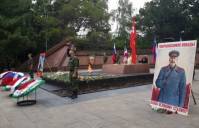Portrait of Stalin appears in Russian-occupied Crimea

DePo reports that a large portrait of Soviet dictator Joseph Stalin has appeared near the Memorial to soldiers of the Second World War in Simferopol. The portrait seems to have appeared on June 22, the anniversary of Nazi Germany’s invasion of Ukraine and beginning of the War for the Soviet Union. There are two stands near the Memorial, with posters from the 1940s glorifying the dictator responsible for the deaths of millions.
The occupation regime’s actions in allowing or promoting this are especially offensive to the indigenous people of the Crimea, the Crimean Tatars who were deported as a people on Stalin’s orders seventy years ago, in May 1944. It is the latest of many affronts including the ban on the traditional remembrance meetings on the anniversary and the fact that veteran Crimean Tatar leader Mustafa Jemiliev has been prohibited from coming to his native Crimea.
An exhibition glorifying Stalin was brought to Simferopol by a Russian group in December 2012 and promptly destroyed by a group of Crimean Tatars, led by members of the Mejlis. The organizers of the exhibition had asserted that they only wanted “an objective picture of the historical figure and head of a great country”.
This has broadly been the line pushed by Russian President Vladimir Putin since around 2007 when he began calls for a ‘more positive approach’ to teaching history. At the Normandy anniversary on June 6 this year he made his support for changing Volgograd back to Stalingrad fairly clear. See: Stalingrad as latest step in glorification of tyrant
In August 2009 a stone was unveiled at the Kurskaya Circle Line Metro Station in Moscow. The inscription read: “Stalin brought us up – to be true to the people. He inspired us to labour and to heroism!”. The words are from Sergei Mikhalkov’s version of the national anthem, and were removed after Stalin was denounced back in 1956. They were reinstated with the claim then being that this was merely for the sake of historical authenticity.
None of the clear moves in Russia to whiten Stalin’s image in school textbooks; to reinstate monuments and return his name to the city where the pivotal Battle of Stalingrad took place have received much attention in the west. There would be international outcry if attempts were made to place Hitler in a ‘historical context”.
Concern at such silence is not only in memory of our relatives and the millions of other victims of a monstrous tyrant. The effective editing of history, downplaying of crimes against humanity and presentation of Stalin as a ‘great administrator’ under whom the Soviet Union achieved ‘greatness’ come at a time when the Kremlin under Vladimir Putin is seeking to regain lost power and ‘glory’, albeit now for the Russian Federation. Putin has already called the collapse of the Soviet empire the greatest catastrophe of the twentieth century, and his aggression against Ukraine is largely due to the vital importance of Ukraine for his grandiose plans for a Euroasian union.
There has been nothing good to say about Russia’s annexation of the Crimea, and its behaviour ever since. Attempts to ‘rehabiltiate’ Stalin may not be among the most pressing concerns after three months of Russian rule, but they are still deeply repugnant and it is a worrying sign.





